FURTHER THROUGH THE EYES OF THE WISE OLD OWL.
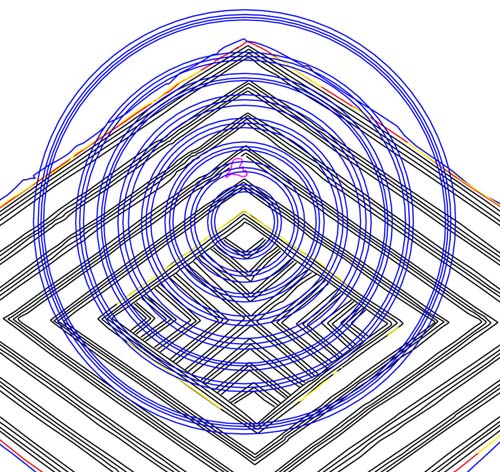
We'll now deal with the coded values that flow downward through
the innermost diamond. As always the circle radii values listed and drawn
are determined precisely in AutoCAD, according to British Standard inches.
Here are the apparent codes:
- .2304 (Great Pyramid face area value, navigation), .2551.5 (7.2 lunar years...calendar),
.2835 (Khafre Pyramid, lunar).
- .384 (navigation, lunar), .41472 (true equatorial circumference), .4608
(11.52 series, lunar, navigation, etc).
- .55 ("11" series navigation), .576 (Great Pyramid, navigation),
.61111 ("11" series navigation).
- .72 ("6" series, navigation), .756 (Great Pyramid, multi-use value),
.792 ("11" series equatorial circumference).
- .891 (Menkaure Pyramid, "Y" Holes, navigation), .93333 ( Sabbatical
calendar), .972 (navigation, lunar nutation).
- 1.08 (Precession, multi-use), 1.1 ("11" series navigation), 1.134
(Stonehenge station stones, lunar nutation cycle).
- 1.236068 (formula for correct volume vessels, PHI), 1.265625 (lunar), 1.296
(Precession of the Equinoxes, navigation).
- 1.542857143 (7th expression breakdowns of 360-degrees), 1.5625 ("11"
series navigation).
- 1.575 ("6&7" series measurements, lunar, PI @ 1.5708), 1.62
(rounded PHI, true PHI @ 1.6180339).
Some of these positions are dual coded and the user of the memory device would
automatically associate 1.575 with 1.5708 simultaneously. The 1.575 progression
was integral to the Greek measurement system (as a rounded form of PI), but
is also found on the inner rim of the Sarsen Circle at Stonehenge. The Sarsen
Circle inner circumference can be dual read as 315 feet (1/2 stadia) or 314.16
feet (a PI reading based upon 100 feet diameter). Similarly, the 1.62 value,
found within many ancient structures from Egypt to Britain (as elsewhere), is
simply a rounded form of PHI and can be dual read (literally or symbolically)
as 1.62 or 1.6180339. The Clandon Barrow or Bush Barrow lozenge devices acted
as memory triggers for the recall of numerous codes, the precise values of which
had been (at some epoch) calculated on an abacus and then committed to memory.
A raft of very essential (traditional) mathematical progressions was available
for every astronomical, navigational and calendar calculation requirement, based
upon unchanging constants within celestial cycles or the dimensions of the Earth.
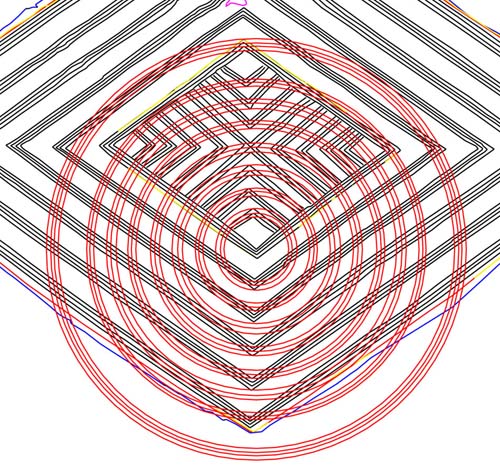
We will now consider the bottom quadrant of the innermost diamond
and the coded values inscribed into stations expanding upward across the diamond.
The circles displayed comply to the exact British Standard inch radii values
listed below:
- .252 (Great Pyramid), .28 (calendar), .3168 ("11" series navigation).
- .4166666 ("10" series), .45 (compass), .4752 ("11"
series navigation).
- .576 (Great Pyramid, navigation, etc.), .611111 ("11" series navigation),
.65625 (lunar, navigation).
- .756 (Great Pyramid, multi-use value), .792 ("11" series equatorial
circumference), .825 ("11" series navigation).
- .9375 (compass, lunar, "11" series navigation), .972 (lunar, navigation),
1 (inch reference).
- 1.1 ("11" series navigation), 1.134 (Stonehenge station stones,
lunar), 1.265625 (lunar).
- 1.296 (Precession of the Equinoxes, navigation), 1.32 (Stonehenge "Z"
Holes, "11 series navigation).
- 1.54285714 (breaking 360-degrees into 700th values), 1.575 (Stonehenge,
lunar & PI dual code).
- 1.6 (8ths divisions in 360-degrees), 1.6335 ("11" series navigation).
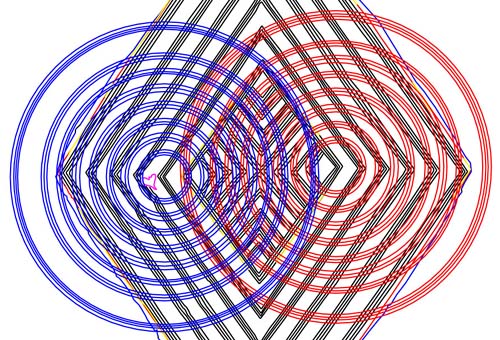
The result of of combining the inward running circle geometry,
top and bottom, showing the lozenge turned 90-degrees anticlockwise.
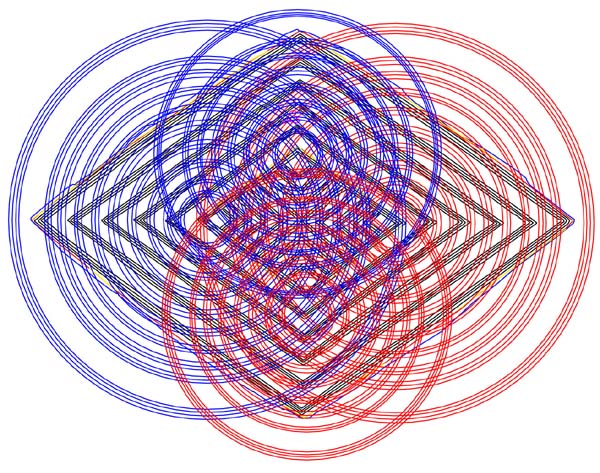
The "all in" circle geometry related to the codes
set out only within the centre diamond of the Clandon Barrow Lozenge (as listed).
This is indicative of the amount of encoding that exists within the lozenge
and the large amount yet to be identified within more extended station positions.
THE UNION JACK FLAG AND THE BRITISH BULLS-EYE INSIGNIA.
In consideration of the way circle geometry was traditionally
used for profound scientific coding in ancient Britain, is it any wonder that
the insignia adopted by the Royal Air Force during W.W.II was a "bulls-eye",
made up of diminishing circles? The Folkton Drums artefacts also display the
"Union Jack" flag, which became the flag of Southern England. The
Union Jack, made up of the "Grand Cross", with the thinner "Cross
of Set" and the "PHI vectors" (which became known as the "Saint
Andrew's Cross") was incorporated into the flags of many countries. These
included the flags of New Zealand, Australia and Canada (which later swapped
over to a "Maple Leaf" insignia). The Union Jack design is a part
of "out of Egypt" geometry and is an abbreviated representation of
more complex star and cross pattern overlays. The overlay system, incorporating
an "8" pointed star, "6" pointed star, "12" pointed
star, Grand cross, thin cross, overlaying rectangles and PHI vectors, constituted
an important part of the mnemonic coding system for astronomy. It was incorporated,
either wholly or partially, into many ancient standing stone circles, ground
geometry systems (such as at Rennes Le Chateau in Southern France) or ancient
coded community buildings (such as
The Crosshouse of Miringa Te Kakara in New Zealand). Let's briefly
touch upon one aspect of this "out of Egypt" geometry, which became
the St. Andrew's Cross, depicted in the central diamond of the Clandon Barrow
Lozenge.... and, equally, upon the Folkton Drums.
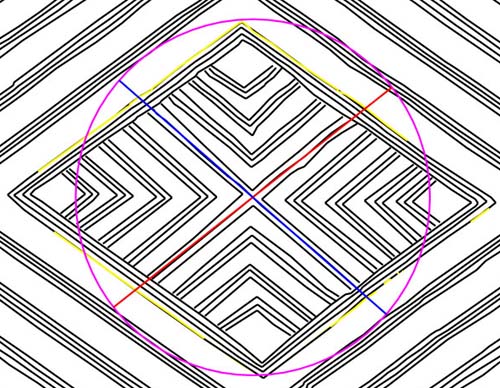
The intended, coded diameter of the circle shown was 1.701
inches. This is a lunar code and there are 4 X 1701 days in the lunar nutation
cycle, anciently calibrated to endure for 6804 days (major standstill of the
moon to major standstill of the moon). The true period is 6798.36 days (18.613
years), but this value will not break down within a mathematical progression,
so 6804 days was used by ancient astronomers to describe the cycle mathematically.
This numerical description is clearly encoded into the dimensions of the Khafre
Pyramid of the Giza Plateau.
The lozenge end points (through its overall
length) were set to 270 degrees and 90 degrees, respectively, in AutoCAD. This
was for the purpose of ascertaining if there were significant degree angle readings
in the central diamond, or along the outer edges of the lozenge. The vectors
shown in the central, diagonally lying cross are at: 51.84 to 131.04 and 231.84
to 311.04 degrees, respectively. One set of vectors is an expressions of the
degree angle 51.84-degrees (the slope angle of the Great Pyramid). The other
vector is an expression of 311.04-degrees and codes the true size of the Earth
(31104-miles = 45-degrees of equatorial arc for the true size of the Earth,
anciently fixed at 24883.2-miles or 12 X 12 X 12 X 12 X 1.2-miles. These two
diagonally lying vectors form a St. Andrew's Cross in the centre of the lozenge.
The 51.84-degree & 311.04-degree angle lines, which were introduced very
precisely within the exacting confines of AutoCAD, perfectly cover the lines
inscribed by the ancient artisan.
The 51.84 number was used copiously in ancient navigation. When
one travels an ancient English league of 16500 feet the circumference generated
from that diameter is 51840 feet (using the navigational rendition of PI @ 3.141818182).
The square footage of the 4 sides of the Great Pyramid (no capstone) plus the
base it occupies is 51.845 Egyptian Pyramid acres of 28800 square feet each
(identified from statements made by Herodotus). The area the Great Pyramid occupies
at its base is 5184 square reeds (of 10.5 feet square each). The azimuth angle
from the altar at the Octagon of Newark, Ohio, earth embankment complex,
through the Avenue and out the extremity gate, is 51.84 degrees. One five hundredth
part of the duration period for the Precession of the Equinoxes (25920 years)
is 51.84 years, etc.
In the picture above the red line is, as stated, set at an angle
of 51.84 degrees around from north (top). The blue line runs up to 311.04-degrees
around from north. 311.04-degrees minus 51.84-degrees = 259.2-degrees. The Heel
stone outer face at Stonehenge sits 259.2 feet from site centre at an angle
of 51.84-degrees to its south facing side. The sum of 311.04-degrees is 360-degrees
minus 48.96-degrees. If the value of 48.96-degrees is added to 51.84-degrees,
then the total is 100.8-degrees. The value of 100.8 feet was 1 second of Earth
equatorial arc under the Great Pyramid "6&7" geodetic assignment,
which sized the Earth to 3024 X 43200 feet (or 130636800 feet...24741.81818-miles).
At Stonehenge's Sarsen Circle inner rim one of the cross measurements between
lintels was 100.8 feet, coding 1-second of arc.
MOONLIGHTING.
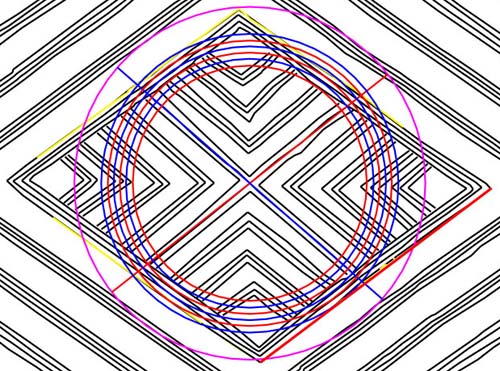
All of the circles shown provide specialised ratios, such that
the astronomer using the lozenge memory device could calculate periods of time
within the 6804 day lunar nutation cycle or the Sabbatical Calendar. The defining
circle for this process is the magenta one, which sweeps to the top and bottom
of the diamond. It's diameter is 1.701 inches, in homage to 1701 days, or a
quarter of the the moon's cycle. Here are the diameters of the other circles,
each of which sweep to touch a pattern line in one quadrant or another around
the diamond:
- .72 inches radius (1.44 inches diameter). The sum of 1.701 ÷
1.44 = 1.18125. The sum of 118.125-days would be 4 lunar months of 29.53125
days each (which is the exact duration of a lunar synodic month to a tolerance
of about 57 seconds).
- .6880689 inches radius (1.376137832 inches diameter). This is simply a half
PHI (.80901695) reduction on the 1.701 inch diameter circle. Sizing circles
and squares in PHI or half PHI reductions to each other was very common practice
on astronomical sites such as Stonehenge. The station keeps the PHI reduction
or expansion of values in memory and is dual coded to also include "rounded
PHI" (1.62). The sum of 1.701 ÷ .81 = 2.1.
- .666666 inches radius (1.333333 inches diameter). The sum of 1.701 ÷
1.333333 = 1.27575. The period of 1275.75 days is 3.6 lunar years. The very
important period that the astronomer had to remember was 2551.5-days, or 7.2
lunar years. The ancient Sabbatical Calendar system, which was lunisolar,
ran for 7 solar years (2556.75 days) concurrently with 7.2 lunar years (2551.5
days). The 5.25 days difference in the periods is the reason the ancient Druidic
priests and their forebears had a mistletoe culling ceremony on the 6th day
after the Winter solstice. It was to provide the offset of 5.25 days, such
that 7 solar years and 7.2 lunar years would terminate on the same day at
the end of the first in a series of 7 Sabbatical cycles. This equates to 49
solar years or 7 X 7 (solar years)...concurrent with 50.4 lunar years within
the same count + allotments of 5.25 extra days per solar year (X 49) to synchronize
the count.
- .63 inches radius(1.26 inches diameter). It was convenient to measure periods
within the lunar nutation cycle (6804 days), the lunar component within the
Sabbatical Calendar (2551.5 days) or the solar component within the Sabbatical
Calendar (2556.75 days) in increments of 5.25 days. It is for this reason
that the "reed" measurement (126 inches) was conceived. It's highly
probable that the staffs carried by early astronomer/ priests were in 1/2
reed lengths and calibrated in 7th increments. They could then be used to
calculate significant lunar or solar periods within the Sabbatical Calendar
or milestones arrived at within the lunar nutation cycle. The sum of 1.701
÷ 1.26 = 1.35. There are 135 periods of 5.25 days in 1701 days.
There are 540 periods of 5.25 days in 6804 days. There are 486 periods of
5.25 days in 2551.5 days. There are 487 periods of 5.25 days in 2556.75 days.
The ancient Calendar
of Coligny bronze plaque artefact, located in Ain, France in
November 1897 AD, is 4.86 feet long (58.32 inches), with a width of 2.953125
feet (35.4375 inches). There are 29.53125 days in a lunar month and 354.375
days in a lunar year.
- .6 inches radius (1.2 inches diameter). This is simply a way of dividing
the 1701 day period into 12 divisions of 141.75 days. This value provides
a mathematical progression that is found upon the Khafre Pyramid of the Giza
Plateau (Egypt's pyramid of the Moon). Khafre Pyramid has a design base length
of 708.75 feet (141.74 X 5).
- .567 inches radius (1.134 inches diameter). There are 15 periods of 113.4
days in 1701 days. The Station Stones rectangle at Stonehenge is 113.4 feet
wide and its width defines the outer diameter of the Sarsen Circle from 225-degrees
azimuth to 45-degrees azimuth.
The Khafre Pyramid (pyramid of the Moon) was built to a 3,4,5 triangle formula,
wherein its dimensions were fluidly divisible by 7 and its side angle was 53.13010235-degrees
(opposing angle 36.86989765-degrees). The lower right external diagonal line
of the inner diamond lies on an angle of 53.13010235 (red line). The line is
1.4 inches long.
MORE LUNAR CODES.
The width of the central diamond is 1.701 inches and that is a dynamic lunar
code associated with the lunar nutation cycle. A series of diminishing circles
within the lozenge then provide ratios for dividing up the cycle into convenient
lesser values.
The length of the inner diamond is dual coded to be 2.3328 inches and 2.333333
inches simultaneously. When read as 2.3328 inches the value is a lunar code
and can be, similarly, subjected to ratio reductions, like the width of 1.701,
to produce very useful lunar values. Also, the lunar nutation cycle of 6804
days or the 2551.5 day period of the moon (7.2 lunar years), used for calibration
within the Sabbatical Calendar system, can be further rendered in useful values
by subjecting them to 1.166666 reductions or increases (2.33333 ÷
2 = 1.166666).
Because of the versatility of the 1.1664 or 1.166666 numbers, they were very
widely used in antiquity as conversion ratios. The Roman foot was 11.664 inches
and 11.66666 inches simultaneously. The Roman Pace was 58.32 inches and 58.333333
inches simultaneously. It's worthy to note that the Calendar of Coligny,
mentioned above, was fabricated to be 58.32 inches long, carrying the 58.33333
inch code simultaneously. The Royal Cubits of antiquity had "common"
counterparts that were 1.166666 in ratio less. The Romans, with their foot of
11.66666 inches were, quite obviously, using a measurement of 10 inches (1.166666
less) for overland distance calibration.
Researchers are encouraged to subject the length aspect (2.3328 or 2.33333
inches) of the inner diamond to the same scrutiny as the width aspect (1.701
inches) and extract, then experiment with, the values derived. It will be seen
that very useful mathematical progressions are created that relate to lunar
work or more general overland distance calculations.
AREA CODES.
The width of 1.701 inches X 2.3328 inches = 3.9680928 square inches for the
area of the innermost diamond. Alternatively, 1.701 inches X 2.3333333 inches
= 3.969 square inches. If these values (in expanded form for convenience) are
subjected to division by significant lunar numbers, then here are the results:
- 39690 ÷ 6804 = 5.8333333....alternatively, 5.832
- 39690 ÷ 2551.5 = 1.555555....alternatively 1.5552 (progression
related to the true equatorial circumference of the Earth @ 24883.2-miles.
This measurement (as 1555.2 feet) is found coded into the the Octagon of Newark,
Ohio, where it is the distance, centre to centre, between the circle embankment
and the octagonal embankments). Numerical values derived from this progression
featured prominently in many "volumes" or "weights" standards
of the ancient Mediterranean.
Similarly, the width or length aspects could be multiplied by the diameters
of the inner circles (including PHI or rounded PHI values) to achieve very useful
numbers and ratios. With regards to the inner circle diameters, the main preoccupation
of the lozenge's user would be to subject numbers like 144, 126, etc., to 1.1666666
increases or decreases, in line with what was happening between "Royal"
and "common" cubit measurements of antiquity.
Each of the diamond compartments within the greater lozenges (Clandon or Bush
Barrow) can be similarly assessed, in the same vein, as that done above. It
will be found that both lozenges have many layers of coding and are very sophisticated,
versatile, scientific mnemonic devices.
The central diamond section of the Clandon Barrow Lozenge has multiples of
(slightly expanded) scale codes related to the Great Pyramid's dimensions or
the equatorial size of the Earth. We'll discuss these as we proceed and find
out what the extractable numbers mean within the ancient astronomical/ navigational
coding system.
CONTINUE





